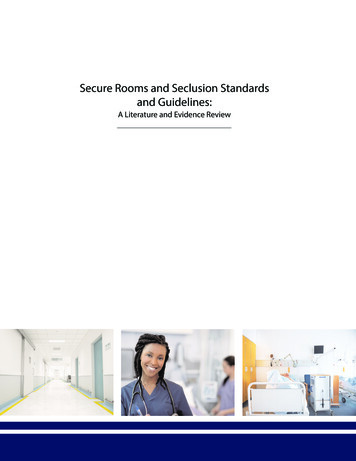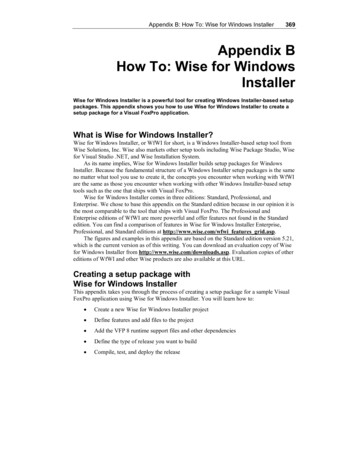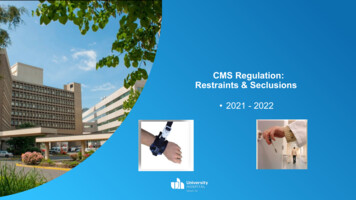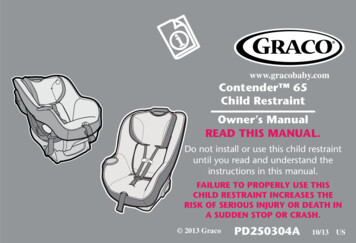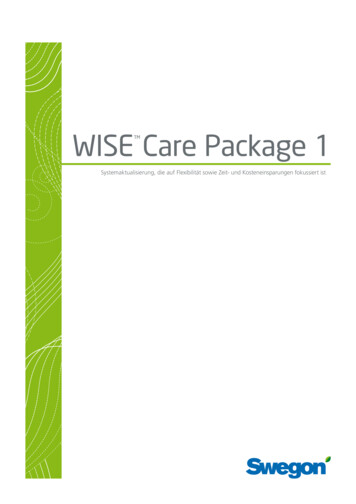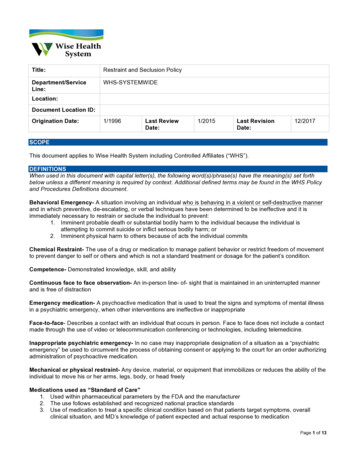
Transcription
Title:Restraint and Seclusion n:Document Location ID:Origination Date:1/1996Last ReviewDate:1/2015Last RevisionDate:12/2017SCOPEThis document applies to Wise Health System including Controlled Affiliates (“WHS”).DEFINITIONSWhen used in this document with capital letter(s), the following word(s)/phrase(s) have the meaning(s) set forthbelow unless a different meaning is required by context. Additional defined terms may be found in the WHS Policyand Procedures Definitions document.Behavioral Emergency- A situation involving an individual who is behaving in a violent or self-destructive mannerand in which preventive, de-escalating, or verbal techniques have been determined to be ineffective and it isimmediately necessary to restrain or seclude the individual to prevent:1. Imminent probable death or substantial bodily harm to the individual because the individual isattempting to commit suicide or inflict serious bodily harm; or2. Imminent physical harm to others because of acts the individual commitsChemical Restraint- The use of a drug or medication to manage patient behavior or restrict freedom of movementto prevent danger to self or others and which is not a standard treatment or dosage for the patient’s condition.Competence- Demonstrated knowledge, skill, and abilityContinuous face to face observation- An in-person line- of- sight that is maintained in an uninterrupted mannerand is free of distractionEmergency medication- A psychoactive medication that is used to treat the signs and symptoms of mental illnessin a psychiatric emergency, when other interventions are ineffective or inappropriateFace-to-face- Describes a contact with an individual that occurs in person. Face to face does not include a contactmade through the use of video or telecommunication conferencing or technologies, including telemedicine.Inappropriate psychiatric emergency- In no case may inappropriate designation of a situation as a “psychiatricemergency” be used to circumvent the process of obtaining consent or applying to the court for an order authorizingadministration of psychoactive medication.Mechanical or physical restraint- Any device, material, or equipment that immobilizes or reduces the ability of theindividual to move his or her arms, legs, body, or head freelyMedications used as “Standard of Care”1. Used within pharmaceutical parameters by the FDA and the manufacturer2. The use follows established and recognized national practice standards3. Use of medication to treat a specific clinical condition based on that patients target symptoms, overallclinical situation, and MD’s knowledge of patient expected and actual response to medicationPage 1 of 13
Restraint and Seclusion Policy[Enter Location]Expectation that the standard use of a psychotherapeutic medication to treat the patient’s condition enables thepatient to be more effective or appropriately function in the world around him/her than would be possible without theuse of medication.Non-violent, non-self-destructive behavior- Behavior related to a non-psychiatric medical condition or symptomthat indicates the need for an intervention to protect the individual from harm.Personal restraint/hold- Any manual method by which a person holds or otherwise bodily applies physicalpressure that immobilizes or reduces the ability of the individual to move his or her body or a portion of his or herbody. Physically holding an individual during a forced administration of a psychoactive medication, including courtordered medication, constitutes a personal restraint/hold. (Maximum 15 minutes). This is a one-time order furtherrestraint requires a physician order for each episode.Protective device- A device used to prevent injury or to permit wounds to heal.Psychiatric emergency--A situation in which, in the opinion of the physician, it is immediately necessary toadminister medication to ameliorate (improve) the signs and symptoms of a patient's mental illness and to prevent:1. Imminent probable death or substantial bodily harm to the patient because the patient:a. Is threatening or attempting to commit suicide or serious bodily harm; orb. Is behaving in a manner that indicates that the patient is unable to satisfy the patient's need fornourishment, essential medical care, or self-protection; or2. Imminent physical or emotional harm to others because of threats, attempts, or other acts the patientmakes or commitsPsychoactive medication- Medication whose primary intended therapeutic effect is to treat or ameliorate(improve) the signs or symptoms of mental disorder, or to modify mood, affect perception, or behaviorRefusal to consent to administration of psychoactive medication (refusal)--Actions which include the followingbehaviors:1. The patient or legally authorized representative communicates orally, through sign language, or inwriting that he or she refuses psychoactive medication.2. The patient communicates through behavior that he or she refuses psychoactive medication, e.g.,refusing to swallow oral medication or refusing to submit to hypodermic injection of psychoactivemedication.3. The patient pretends to swallow oral psychoactive medications, and the attending physician determinesthat the pretending behavior is due to an unwillingness to take the medication.4. The patient gives either no response or a noncommittal response after he or she has received thestandard risk-benefit explanation.Restraint- The use of any personal restraint/hold or mechanical restraint that immobilizes or reduces the ability ofthe individual to move his or her arms, legs, body, or head freely.A drug or medication, when it is used as a restriction to manage the patient’s behavior, or restrict the patient’sfreedom of movement is a restraint, not as a standard of care or dosage for the patient’s condition.Seclusion- The involuntary separation of an individual from other individuals for any period of time and or theplacement of the individual alone in an area from which the individual is prevented from leaving. Being in a lockedroom or posting a security guard at the door that is preventing the patient from leaving is seclusion.Seclusion room- A hazard-free room or other area in which direct observation of an individual can be maintainedand from which the individual is prevented from leaving.Supportive device- A device voluntarily used by an individual to posturally support the individual or to assist theindividual who cannot obtain or maintain normal bodily function.Page 2 of 13
Restraint and Seclusion Policy[Enter Location]POLICYWHS ensures clinical justification of restraint use, while protecting patient rights, dignity and well-being.PROCEDUREExclusions to policy:The following are not considered restraints and are not subject to the CMS, TAC, or TJC standards:1. Limitation of mobility or immobilization for medical, dental, diagnostic, or surgical procedures, includingpost-procedure care2. Adaptive support used in response to a patient’s need (i.e. postural support, ortho appliances)3. Protective equipment, papoose boards, IV arm boards, hand mitts that do not limit movement of fingers andare not tied down4. Gurney or bed rails used for sedated patients or for those experiencing involuntary movements or onseizure precautions5. Use of 4 side rails on a bed in constant motion for improved circulation or prevention of skin breakdown6. Side rails on stretchers7. Forensic restrictions (handcuffs, shackles, or seclusion) imposed by correctional authorities.8. Holding a child for medical reasons such as to giving an antibiotic shot, starting an IV, or doing a lumbarpuncture9. Methods used to permit the patient to participate in activities without the risk of harm i.e. walkersGeneral Restraint Use1. Family notification will be made as soon as feasible if patient consents to family being informed ofcondition.a. Family notification will be documented in the medical record.i. The date and time of the notification with the name of the staff member contacting thefamily and shall include any unsuccessful attempts made, the phone number called, andthe name of the person with whom the staff member spokeb. Explain to the patient/family the plan and rationale for using restraints and the conditions/behaviorsrequired for the release from restraints.2. Modify plan of care when restraints are initiated, method is altered, or upon discontinuation of restraintsa. The plan of care will reflect any use of psychoactive medication as part of an integrated treatmentapproach aimed at increasing the patient’s functioning and quality of life.3. Restraints will be discontinued at the earliest possible time. At any time during the restraint or seclusionprocess, they may be discontinued by a RN, physician, or AHP/LIP should re-evaluation determine they areno longer necessary.a. Discontinuation is documented in the medical record including the circumstances under whichrestraint or seclusion is discontinued.4. If restraint or seclusion is discontinued prior to the expiration of the original order, a new order must beobtained prior to reinitiating the use of restraint or seclusion.5. Restraint or seclusion orders may not be written as “standing” or “prn”.6. Apply the appropriate sized restraints snugly to the body part, but not tight enough to interfere withcirculation or breathing.7. When using a limb restraint, use a slip knot and fasten restraints to the bed frame, not to the side rails.8. Place call light within reach of patient in restraints, when not in line of sight care9. Hand-off communication, at shift change, will include information regarding the time of restraint orseclusion treatment was initiated, the current status of the patient’s physical, emotional and behavioralcondition, and the specific criteria for release necessary for the patient to be removed from restraint orseclusion10. Patients in restraints will have an environment that is free of hazards, adequately ventilated andappropriately lighted.11. Forensic patients with physical restrictions will be monitored for safety issues, circulation, ADL, nutrition,and hygiene needsPage 3 of 13
Restraint and Seclusion Policy[Enter Location]12. Forensic patients in the operating room requiring shackles will be restrained with appropriate nylon orplastic cable-tie restraints for OR safety.a. OR positioning will be done per the safety standards for safe positioning in collaboration with thecorrectional officer.13. Restraints not in use should be removed from the individual’s room14. See “Restraint Application and Monitoring” in Elsevier Skills for proper restraint application techniques.NOTE: Disruptive or behavior deemed dangerous to self or others may necessitate immediate intervention andrestraint by trained security or other trained personnel in any treatment area of the facility. In such a case, theleast restrictive method of restraint effective will be used, and restraint will be released when immediate dangeris resolved. In the out-patient setting, the patient will be escorted from the premises when feasible or local lawenforcement authorities will be contacted.Least restrictive alternatives:Restraints methods or devices are only used when less restrictive interventions have been determined ineffective toprotect the patient or others from harm. Non-physical interventions will be used whenever possible. Restraintmethod selected will be the least restrictive method possible and will be applied with consideration of patient’s age,physical abilities, and without restriction of circulatory or respiratory status. (For example, if a patient only requires2 restraints instead of 4, then only 2 should be used).1. Clinical Timeouta. A procedure in which an individual, in response to verbal suggestion from a staff member,voluntarily enters and remains for a period of time in a designated area from which the individual isnot prevented from leavingb. Clinical timeouts will be documented in the patient’s EMR and will include the condition underwhich the time was suggested and the individual’s response to the suggestion.c. Prior to a clinical timeout, the staff member suggesting that an individual initiate a clinical timeoutshall explain to the individual that the timeout is voluntaryd. The decision by the individual to decline to begin, or remain in, clinical timeout or similarinterventions may not result in the staff member’s use of restraint or seclusion of the individual,unless it is permitted under the requirements for restraint and seclusion.2. Quiet time:a. A procedure in which an individual, on the individual’s own initiative, enters and remains for aperiod of time in a designated area from which the individual is not prevented from leaving. Unlessclinically contraindicated, patient will be granted quiet time.b. Staff members may not mandate quiet time and the individual may terminate quiet time at any time.c. On every occasion that quiet time is denied or terminated for clinical reasons, a staff member shalldocument in the medical record the conditions under which the quiet time was denied orterminated.3. For purposes of the unit, other alternatives may include:a. De-escalation and verbal techniquesb. Redirectionc. Meditationd. Problem solvinge. Reflective listeningf. Offer snack or other item(s)g. Reduce stimulation of environment, patients, or soundsh. Offer listening to music and watching TV in another locationi. Remove other patients that are being bothersomej. Allow or disallow visitors (with appropriate doctor order)k. Move patient room if clinically appropriatel. Offer an extra smoke break (only when clinically appropriate and safe for patients and staff)m. Call to family or talk about their support systemn. Offering other medications that could assist with pain, sleep etc. that could benefit the patient at thetime of his/her escalationo. Obtain specific orders from the doctor if any patient rights or privileges are being restricted (i.e.telephone privileges, visitation, etc.)Page 4 of 13
Restraint and Seclusion Policy[Enter Location]NON-VIOLENT, non-self-destructive restraint useNon-violent restraints are used for the purpose of promoting healing and to protect the patient’s safety1. Criteria for non-violent, non-self-destructive behavior restraint use (not all-inclusive):a. Attempted removal or dislodgment of intravenous lines, central lines, or other tubes by patient,resulting from confusion or inability to understand the potential benefits of these treatmentmodalitiesb. Attempted self-extubation of endotracheal tubes, resulting from confusion or inability tounderstand the potential benefits of these treatment modalitiesc. Determination is made that risks of removal or dislodgment may result in bleeding, infection,injury, or death2. Non-violent, non-self-destructive restraints may include the following (list not all-inclusive):a. The use of 4 side rails for the purpose of preventing the patient from exiting the bed (only initialorder required)b. Use of a net bed or enclosed bedc. Freedom splints for limb immobilizationd. Use of a Geri chair with tray patient is unable to remove on his/her own (only initial orderrequired)e. Soft wrist restraints3. Restraint must be medically necessary, ordered by a physician, needed to ensure the individual’s safety,and used only after least restrictive measures have failed.4. Prior to the application of the restraint, the individual will be assessed and the determination made that therisks associated with the use of the restraint are outweighed by the risks of not using it.5. The physician or other LIP shall examine patient within 24 hours of initiation of restraints, entering writtenpatient-specific order for restraints.6. Every 2 hours trained staff will assess and document the following, as applicable:a. hygiene needsb. ADL needs,c. toiletingd. feedinge. circulation to restrained extremitiesf. positioning needsg. mental statush. skin integrityi. cardiac functionj. range of motion exercisesk. level of distress7. Care provided will be documented in the EMR8. The physician must examine the patient and place a new order for continuation of restraints for non-violentpatients every calendar day.9. The restraints may be temporarily released and reapplied for the purposes of caring for the patient needs,such as elimination, feeding, range of motion, ADL care, etc.VIOLENT or self-destructive behavior restraint and seclusion use1. Criteria for violent or self-destructive behavior restraint/seclusion use (not all inclusive):a. The patient is violent, hitting staff or peers, throwing objects at staff or peersb. Is a danger to self or othersc. Imminent probable death or substantial bodily harm to the patient because the patient:i. Is threatening or attempting to commit suicide or serious bodily harm; orii. Is behaving in a manner that indicates that the patient is unable to satisfy the patient'sneed for nourishment, essential medical care, or self-protection; ord. Imminent physical or emotional harm to others because of threats, attempts, or other acts thepatient makes or commits2. The physician or other LIP for care will conduct an in-person evaluation within one hour per Medicareguidelines. This evaluation may be performed by a trained RN. If the 1 hour assessment is conducted by atrained RN or a LIP he or she consults with the attending physician or other physician responsible for thecare of the patient as soon as possible.Page 5 of 13
Restraint and Seclusion Policy[Enter Location]3. Within 1 hour of application of restraints physician, AHP/LIP or trained RN will evaluate and document aface to face with the following criteria (not limited to):i. Evaluation of the patient’s immediate situationii. Patient’s reaction to the interventioniii. Patient’s medical and behavioral conditioniv. The need to continue or terminate the restraints/seclusion4. If a physical hold is used for forced medication is necessary, the 1 hour face to face requirementapplies.5. During the in-person evaluation, the physician or LIP should attempt to identify methods to help the patientregain control, revise the plan of care, and provide a new written order, if necessary.a. The initial assessment will be included in the evaluation of the need for intervention entering writtenpatient-specific order for restraint protocol, reason restraint is needed, alternatives tried prior torestraint, and criteria for discontinuation of restraints on medical record.6. Maximum time allowed for violent or self-destructive restraint or seclusion is 4 hours for adults7. If continued restraint or seclusion is warranted after the first 4 hour period expires then a new restraintorder will be needed with the elements listed above. There must be an RN assessment prior to a new orderrequested.8. Trained staff will assess the patient upon initiation of restraints/seclusion for violent or self-destructivebehavior at 15 minute intervals for the following:a. Correct application of restraintsb. Signs of injury associated with restraint applicationc. Circulatory statusd. Respiratory statuse. Skin integrityf. Vital signs as deemed necessary for patient condition/assessmentg. Physical and psychological status and comfort, response to restraints/seclusionh. Signs and symptoms of distressi. Patient’s rights, dignity, and safety are maintainedj. Readiness for less restrictive method or discontinuation of restraints9. At 1 hour intervals, or more frequently as indicated, and if safe; the patient in restraint or seclusion will beprovided:a. Range of motion of at least 5 minutes must be performed for each extremity restrainedb. Changing of position10. At 2 hours intervals, or more frequently if indicated, and if safe; the patient in restraint or seclusion will beprovided:a. Bathroom privileges and appropriate hygieneb. Opportunity to drink water or other appropriate hydration (more frequently if requested and notclinically contraindicated)11. Patient will receive regularly prescribed medications, unless otherwise ordered by the physician12. Patient will receive regularly scheduled meals and snacks served on ware that is appropriate for safety13. The ordering physician or LIP must renew restraint order for violent, self-destructive behavior per thesetime frames:a. Every 4 hours for patients ages 18 and olderb. Every 2 hours for patients ages 9-17c. Every 1 hour for patients under age 9d. Personal restraint/hold not to exceed 15 minutes14. A physician may renew the original order provided it would not result in a period exceeding:a. A personal restraint/hold beyond 15 minutes total from the time of initiation of the original personalrestraint/holdb. 8 executive hours for adultsc. 4 executive hours for ages 9-17d. 2 executive hours for ages under 9i. Prior to issuing a continuation order for restraint or seclusion beyond the above hours, thephysician will perform a face-to-face evaluation of the patient. If continued restraint orseclusion is deemed medically necessary all procedures listed above will be addressedand a new order obtained.15. During the reevaluation, practitioner should attempt to identify methods to help the patient regain controland review the treatment plan for effectiveness.Page 6 of 13
Restraint and Seclusion Policy[Enter Location]16. If the determination is made that the restraints are no longer needed )i.e. the patient is no longer violent,hitting staff or peers and is not a danger to self or others) restraints will be discontinued17. A reapplication of restraints for subsequent episodes will require a new order for re-initiating restraintsOther considerations for Restraints and Seclusion1. Any patient who is in both Restraint and Seclusion must be continuously monitored on a 1:1 basis.Restraint and Seclusion can only be used for patients who are violent and/or self-destructive.2. The use of seclusion is prohibited except in behavioral emergencies or psychiatric emergencies.3. Verify that the order for restraint/seclusion includes rationale for restraint/seclusion, length of time and typeof restraints, if any, to be used, the extremity or body part(s) to be restrained. Determine if alternative, lessrestrictive methods have been attempted and were ineffective4. Explain to the patient and/or the family the plan and rationale for using restraints/seclusion and theconditions/behaviors required for release of such5. Trained staff must provide continuous in-person observation and monitoring of patient in restraint andseclusion. After the first hour, this may be done via remote video and audio equipment in close proximity ofthe patient, if consistent with patient’s condition and wishes.Ordering and Initiation of restraint useRestraints and or seclusion may never be used as a means of coercion, discipline, convenience, or staffretaliation and will not be based solely upon patient history of dangerous behavior.1. When non-physical interventions are ineffective or not viable, an order for restraint must be issued by aphysician, LIP, or in their absence, by a trained RN based upon patient assessment.a. In the absence of the physician the RN must immediately notify the physician of restraint initiation,obtaining a telephone or written order.b. The RN initiating the restraint shall note in the patient’s record the name of the physician contacted,the time of the contact and any correspondence he or she had with the physician.c. The attending physician must be consulted as soon as possible if the attending physician did notorder the restraint.d. If the RN initiates restraint or seclusion contact the physician as soon as possible for restraint/ andor seclusion order.e. If order is taken by telephone, then must be authenticated within 24 hours by physician whoordered the restraint or seclusion2. Physician’s order will include:a. Date, Time, & Signatureb. Type of restraintc. Extremity or body part(s) to be restrainedd. Duration of the restrainte. The reason restraint is necessaryf. Criteria for discontinuation of restraints/seclusiong. Frequency of assessment and how the individual’s circulation, hydration, ADL, vitals, nutrition,mental status, and range of motion will be assessed and addressed.3. In a behavioral emergency the physician can order restraint and seclusion taking into account anyapplicable medical or psychiatric contraindications to restraint or seclusion.4. The RN can also initiate restraint and seclusion when the physician is not on the unit and must also takeinto account any applicable medical or psychiatric contraindications to restraint or seclusion.5. If the ordering physician is not the treating physician, a consultation with the treating physician will bedocumented in the individual’s medical record no later than the next business dayMonitoring and Observation of patients in restraints or seclusionPatient assessments, monitoring, and observations will be documented in the EMR per the above guidelines:1. A staff member of the same gender as the patient, if possible, will provide continuous face-to-faceobservation of a patient in a mechanical restraint or seclusion, unless the individual’s history or otherfactors indicate this would be contraindicated (e.g. sexual or physical abuse perpetrated by someone of thesame gender, in which case a staff member of the opposite gender may be used)2. A staff member who is not physically applying personal restraint/hold shall maintain a continuous face-toface observation of an individual in a personal restraint/holdPage 7 of 13
Restraint and Seclusion Policy[Enter Location]3. Respect for privacy will be maintained for any patient in any type of restraint4. Nutrition, hydration, ADL, medications and treatments, and toileting needs will be met. An opportunity tobathe at least once daily (or more frequently and not contraindicated, or otherwise required by theindividual’s circumstances and physical or medical needs)Documentation will include (not limited to):Along with other required documentation mentioned in policy, the following will be documented:1. Date and time intervention(s) began and ended2. Name, title, and credentials of any staff members present at the initiation of the intervention, with the staffmember’s role in the intervention, including as observer, or status as an uninvolved witness, as applicable3. Time and results of any assessments, observations, monitoring, evaluations, and attention given topersonal needs4. Physician’s documentation5. Any specific alternatives or least restrictive measures, including preventative or de-escalatory interventionsthat were attempted by any staff member prior to the initiation of restraint or seclusion, and the individual’sresponse to any such intervention6. The individual’s response to restraint and seclusion7. Patient/family education and restraint education comprehensionRelease from Restraint or Seclusion1. Staff will discuss with the patient (in a language that is understandable to the patient) as soon as possibleafter restraint and/or seclusion has been implemented:a. Specific behaviors that necessitated restraint or seclusionb. How the patient’s behavior continues to meet the criteria for restraint or seclusionc. The behaviors that must be demonstrated by the patient to be released from restraints or seclusiond. Patient’s suggestions about what staff can do to assist the patient in gaining release from restraintor seclusione. If the patient does not appear to understand the information staff will attempt to re-explain it every15 minutes until understanding is reached, or the order for restraint or seclusion has expired. Staffwill document all attempts to communicate with the patient2. Once the patient meets the criteria for release stated on the order then the patient must be released fromrestraint or seclusion immediatelya. The determination for release will be based on patient’s present behavior3. A personal restraint/hold will be terminated immediately after the medication is given and no longer than 15minutes.4. If an emergency health situation occurs the patient will be released from restraint or seclusion immediatelyas dictated by the emergency5. When a patient falls asleep in restraint or seclusion, a registered nurse will assess to determine if patient isasleep. If determined to be asleep, he/she will be released immediatelya. Continuous observation of the patient will be maintained until the patient awakens and is evaluatedb. A patient who falls asleep in restraint or seclusion, will be evaluated by the registered nurse or thephysician upon awakening since they no longer meet the criteria for restraint or seclusionc. When the patient falls asleep in restraint or seclusion the door will be unlocked and open6. Staff will take appropriate action to facilitate the patient’s re-entry and the opportunity to return to ongoingactivities and social milieu7. The staff will observe the patient for at least 15 minutes and document in the EMR the steps taken andobservations made of the individual’s behavior during the transition period.8. The patient will be placed back on level of observation as ordered by the physicianNote: For the Behavioral Health Unit; following release the treatment team will review alternative strategies fordealing with behaviors necessitating restraint or seclusion and provide written modification to the patient’s plan ofcare. The treatment team will focus on least restrictive measures and alternative treatments as well as any new riskfactors.Page 8 of 13
Restraint and Seclusion Policy[Enter Location]Psychiatric EmergenciesIf a physician issues an order to administer psychoactive medication to a patient without the patient's consentbecause of a psychiatric emergency, then the physician will document in the patient's clinical record in specificmedical or behavioral terms:1. Why the order is necessary:2. Other generally accepted, less intrusive forms of treatment, if any, that the physician has evaluated butrejecte
Page 1 of 13 Title: Restraint and Seclusion Policy Department/Service Line: WHS-SYSTEMWIDE Location: Document Location ID: Origination Date: 1/1996 Last Review Date: 1/2015 Last Revision Date: 12/2017 SCOPE This document applies to Wise Health System including Controlled Affiliates ("WHS").
